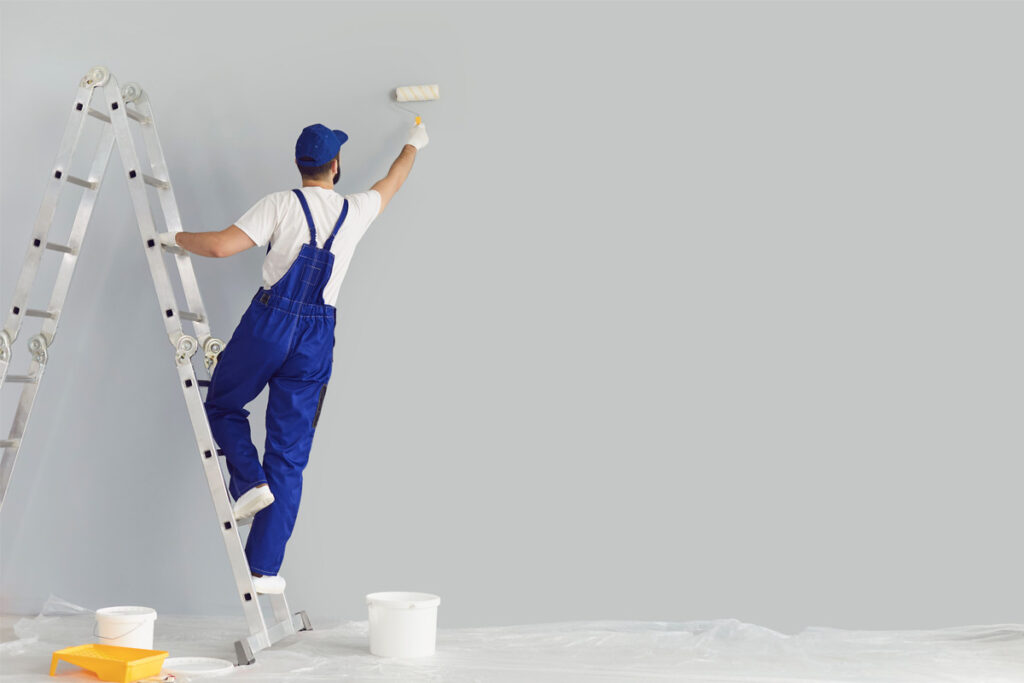The walls of your home set the tone for every room, influencing both comfort and style. Over time, paint begins to fade, chip, or lose its vibrancy, leaving spaces looking tired and dated. These changes not only affect how your home feels but can also reveal underlying issues like moisture damage or poor air quality.
Repainting at the right time keeps your home looking fresh while protecting the walls from further wear. By recognizing the signs early, you can maintain a beautiful and well-cared-for living environment.
How Fresh Paint Transforms More Than Just Your Décor
A fresh coat of paint does more than improve the look of your walls; it can completely change the atmosphere of your home. Beyond appearances, it also protects your walls from wear, moisture, and damage that naturally occur over time. Repainting is both a style upgrade and a form of maintenance that benefits your comfort and the long-term condition of your home.
- Brightens and Refreshes Your Space
New paint has the ability to alter the way light reflects in a room, making previously dim areas appear more open and inviting. This effect can dramatically shift the overall atmosphere, creating a more vibrant and uplifting setting. The change is not only visual but also impacts how you perceive and use the space daily.
- Protects Walls from Damage
High-quality paint functions as a protective barrier, shielding your walls from moisture, dirt, and minor abrasions. This layer reduces the risk of long-term structural issues that can arise from exposure to humidity or everyday wear. As a result, your walls remain intact and easier to maintain over the years.
- Enhances Your Home’s Value
Regular residential painting shows that the property has been properly cared for and maintained, which immediately appeals to potential buyers or renters. Updated colours and finishes contribute to a contemporary, polished look that feels move-in ready. This seemingly small investment can significantly influence the market value of your home.
- Improves Mood and Atmosphere
Colour psychology shows that tones and shades can directly impact emotional states, from calm neutrals to energizing brights. A new coat of paint allows you to deliberately choose how you want each room to feel and function. This intentional design choice shapes your everyday comfort and overall sense of well-being.

How to Tell When It’s Time for a New Coat Indoors
Knowing when to apply a new coat of interior paint can make a big difference in the look and longevity of your home. Walls naturally show signs of wear over time, and ignoring them can lead to more costly repairs later. Paying attention to specific indicators will help you decide the right moment to refresh your space.
- Fading or Discoloured Paint
Over time, paint loses its brightness. Sunlight, smoke, and even household cleaning products can make colours look dull or uneven. A once-vibrant wall may now seem washed out, changing the entire feel of the room.
Repainting restores colour to its original depth and freshness. It also gives you the chance to update the shade if your tastes have changed. If the fading is uneven, such as lighter patches near windows, this is a clear sign your walls are ready for a new coat.
- Peeling, Cracking, or Bubbling Paint
When paint begins to peel, crack, or bubble, it often points to underlying issues. Moisture, humidity, or improper surface preparation are common causes. Not only does it look unattractive, but it can also leave your walls unprotected.
If left untreated, the exposed areas can lead to further damage. Repainting after proper surface preparation and repair create a smooth and consistent finish. This step also prevents future peeling by sealing the surface correctly.
- Stains and Scuff Marks That Won’t Wash Off
Walls take a lot of wear, especially in high-traffic areas. Over time, scuffs, stains, and marks build up and stop responding to cleaning. Scrubbing too hard can even damage the surface, making the wall look worse.
A new coat of paint covers these stubborn spots. It gives your home a fresh, polished appearance without the frustration of endless cleaning. With the right finish, future marks will also be easier to wipe away.
- Outdated Colours
Trends and personal styles evolve over time. What felt stylish years ago might now seem out of place with your current décor. Certain shades can even make a room feel smaller or darker than it really is.
Refreshing the walls with modern colours can instantly change the atmosphere of a room. Neutrals provide a timeless backdrop, while bold accents can add personality. Updating colours is one of the easiest ways to breathe new life into your home.
- Damage from Moisture or Mould
Moisture is one of the most damaging issues for walls. Signs include bubbling, soft spots, or patches of mould. These problems not only look unpleasant but can also affect your health if ignored.
Addressing the source of the moisture is the first step. Once repaired, repainting will protect the surface and restore the look of your walls. Using high-quality, moisture-resistant paint can also help prevent future issues.
- Walls Feel Rough or Chalky
When you run your hand across a wall and feel a powdery residue, the paint has broken down. This chalky surface shows that the coating is deteriorating and no longer protecting the wall. The rough texture can also make cleaning difficult.
Repainting solves this problem by creating a smooth, durable surface. Proper preparation, including cleaning and priming, ensures the new paint adheres well. This not only restores the look of your walls but also extends their lifespan.
- Preparing for a Sale or Rental
First impressions matter when showing a home. Prospective buyers or renters notice the condition of walls right away. Dull, chipped, or outdated paint can make the property feel neglected.
Fresh, neutral paint helps create a clean and welcoming environment. It allows buyers and tenants to picture themselves living in the space. Investing in repainting can also increase the market value and make the home more appealing.
- Allergies or Health Concerns
Old paint can trap dust, allergens, and even traces of mould. This can worsen indoor air quality, especially for those with asthma or sensitivities. Paint used decades ago may also contain harmful chemicals.
Repainting with modern, low-VOC options improves the health of your living space. These paints release fewer emissions and reduce exposure to irritants. A fresh coat not only updates your walls but also supports better air quality for your family.
- Frequent Room Use and Wear
Some rooms in a home naturally experience more wear and tear. Hallways, kitchens, and children’s rooms often show scratches, chips, and marks more quickly. Daily use makes it hard to maintain a spotless appearance.
Repainting these areas restores their look and strengthens the walls against further wear. Choosing a durable finish, such as satin or semi-gloss, makes cleaning easier. This helps busy areas of your home look well-kept for longer.
- Simply Wanting a Change
Sometimes repainting doesn’t come from damage at all. Your tastes might evolve, or you may want a new look to match updated furniture. Even subtle changes in shade can have a big impact on the mood of a room.
Painting is an affordable way to refresh your space without major renovations. It allows you to personalize your home and keep it aligned with your style. A new colour can bring energy to a room or create a calming retreat, depending on your preference.
Tips for a Successful Interior Repaint
Repainting can feel overwhelming, but the right approach ensures great results. Planning ahead, using quality materials, and proper preparation make all the difference. Whether you do it yourself or hire professionals, these tips will guide you toward a smooth project.
- Choose High-Quality, Low-VOC Paint
Premium paint lasts longer, covers better, and improves indoor air quality. Low-VOC options reduce harmful fumes, making the process safer for everyone at home.
- Pick Colours that Fit Both Style and Function
Neutral tones work well in most rooms, while accent walls can add character. Think about how natural light affects the space and choose shades that complement it.
- Prepare the Walls Properly
Cleaning, sanding, and priming create a smooth surface that holds paint better. Skipping this step can cause peeling or uneven results, so preparation is essential.
- Use the Right Finish for Each Room
Matte finishes hide imperfections, while satin or semi-gloss finishes work better in high-traffic spaces. The right choice balances style and durability.
- Consider Hiring Professionals
Skilled painters bring expertise, tools, and efficiency. They ensure even coverage and save you time while delivering a polished finish.
Frequently Asked Questions
- How often should I repaint my home’s interior?
On average, interior walls should be repainted every 5 to 7 years, though high-traffic areas may need more frequent updates. Factors such as humidity, sun exposure, and daily use can shorten this timeline.
- Should ceilings be repainted at the same time as walls?
Repainting ceilings together with walls provides a consistent, fresh look and prevents the ceiling from looking dull in contrast. It also saves time and effort since the space is already prepared for painting.
- Is it worth hiring professionals instead of doing it myself?
Hiring professionals ensures a flawless finish, proper surface preparation, and long-lasting results. While DIY painting can save money upfront, it often leads to uneven coats and the need for touch-ups sooner.

Refresh Your Home with Gil Painting
If you’ve noticed any of these signs, it’s time to consider a professional touch. As a trusted painting contractor in Toronto, Gil Painting can help restore your walls with precision and care. From choosing the right colours to applying a flawless finish, our team ensures your home looks its best.
Don’t wait for fading walls or peeling paint to take away from the beauty of your home. Call us at 647-998-4164, and let us handle the hard work while you enjoy the results. A fresh coat of paint is one of the easiest ways to give your home new life.


